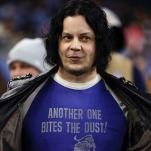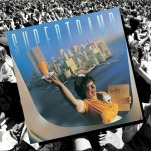Get Smart invented the sitcom mythology

For most of the history of television, the barrier to syndication—and to profitability—has been 100 episodes. The shows that have made it to that mark are an unusual group. Many were big hits. Some found small cult audiences. Still others just hung on as best they could and never posted numbers quite low enough to be canceled. In 100 Episodes, we examine the shows that made it to that number, considering both how they advanced and reflected the medium and what contributed to their popularity.
It would be inaccurate to call Get Smart TV’s first cult comedy, because there are numerous series fitting that description that precede it or aired simultaneously to it. But look a little more closely at the run of Mel Brooks and Buck Henry’s daffy spy spoof, and the series starts to look slightly more like any one of a number of low-rated, critically beloved series that have struggled their way to 100 episodes over the medium’s history. Its humor was less broad than the standard television comedy and was based in audiences knowing something of what it was talking about. The series’ run capped out at five seasons, and it only got there because of some combination of goodwill and pluck. Get Smart probably should have been canceled after its second season, but it hung on, and it eventually became a television classic. But it was decidedly a near thing.
One of the most persistent critiques of the cult comedy—and let’s use Community as an example here—is that its humor is based less in “character” than in gags, whatever that means. For Community, this has often resulted in the argument that the show’s humor derives from “memes,” from the show taking things that were popular about it (or even things that originated amid the show’s online following) and then mainstreaming them into the show before talking about them so many times that viewers might groan to even hear those jokes repeated again. The argument here suggests that this is somehow a new way of telling TV jokes and that it requires the audience to be intimately familiar not just with the show but with the community surrounding the show. The meme is meant to be a lesser form of humor than a well-constructed character-based gag, the kind of joke that will only be funny in the context of knowing the character involved in it and understanding the situation it’s presented in.
Leaving aside for a moment the thought that a sitcom character one person deeply attaches to can be seen by another person as a one-dimensional laugh generator and little else (an inevitability of this genre), the idea of meme-based comedy being a new invention isn’t really accurate. It’s certainly a new development to call this sort of comedy, but sitcoms have had catchphrases and running gags since they were invented, and even the best sitcoms of all time have leaned into these a little too heavily at one time or another. But to look at Community and Get Smart is to realize that there is a certain kind of comedy that highlights these elements intentionally and points out their artificiality to heighten the humor by inviting the viewer to examine the discrepancy between fiction and the real world. Compare this to something like, say, Cheers, where the stories are meant to be intentionally grounded and realistic. This is not to say that these “sitcoms about sitcoms” can’t be grounded and realistic, but it’s rarely their primary reason for existence.
Get Smart’s primary reason for existence was to offer a goofy spoof of James Bond, the most popular pop culture touchstone of the mid-’60s world the sitcom arose out of. The show was launched in the shadow of The Man From U.N.C.L.E., a fellow spy series with a streak of whimsy, but Get Smart quickly ran toward the humorous side of things, more so than anything resembling a real spy story. There were missions of the week, and the agents at the center of the show went on adventures, but these stories were often taken wholesale from books or movies, the better to simply give everyone room to riff on pop culture tropes and come up with the silliest possible gags and gadgets. Take, for instance, an early spoof of Murder On The Orient Express, which takes the idea of murders happening onboard the famous train to provide the actors with the opportunity for wacky jokes and slapstick.
In many ways, what Get Smart most resembles is one of those giant, two-page spreads in Mad magazine that picked some movie or story in the public consciousness and mined it for as many jokes as possible, the reader’s eye scanning slowly across the expanse to drink in all of the detail. These spreads were rarely about telling a story or even about the quality of the art—which was exceptional—so much as they were about cramming those two pages with as many possible references and jokes as the writer and artist could come up with. Similarly, Get Smart may feel slow to modern eyes, which are more accustomed to the gag-a-second pace of our modern sitcoms, but at the time, it was wilder and more sensational than other sitcoms that dominated the period. Brooks told Time magazine at the time that he found the many housebound comedies of the era to be stultifying and bland. He and Henry wanted to push at the boundaries of what a TV sitcom could be.
Fortunately, they were operating at a time when that definition was increasingly pliable, even if it resulted in many, many bad shows. The ’60s were the height of the gimmick sitcom, the show that had at its center some larger-than-life, high-concept idea. One of the top shows on TV when Get Smart debuted on NBC in the fall of 1965 was also one of the best gimmick sitcoms, Bewitched. And the two programs that led into Get Smart that fall were Flipper—the lovely tale of a boy and his dolphin—and I Dream Of Jeannie—basically Bewitched but with a genie. This was also the era of The Monkees and Gilligan’s Island and My Favorite Martian, shows that sometimes seemed as if they’d been thrown on the air because network executives were frantically trying to keep the very scary real world from intruding on the small screen. Thus, Get Smart came to airwaves during one of the few times when it could reasonably be called one of the more realistic comedies on television. It didn’t take place in the reality viewers were used to, but it took place in a sidelong version of that reality, one where the endless posturing of the Cold War was more than a little ridiculous.
That first season was likely the height of Get Smart’s cultural influence. It landed at 12th place in the Nielsen ratings, building solidly off the programs that preceded it and beating out its chief timeslot competition, The Lawrence Welk Show. Reviews were largely kind—though the show had its detractors—and when it came time for the Emmys, the program received four nominations, including nominations for Brooks and Henry’s pilot script, “Mr. Big,” and for the series itself. The show would spend its first four seasons as an Emmy mainstay, eventually winning two comedy series trophies for its third and fourth seasons and winning three consecutive trophies for best actor in a comedy for series star Don Adams.
It was Adams who pulled all of the disparate tones of Get Smart together, who kept it from being just a weekly spoof of spy movies. His Maxwell Smart isn’t a particularly deep character—it’s difficult to imagine him having complex or thought-provoking layers—but he is a surprisingly effective spy, at least in terms of his stats. Smart usually gets his man, or, more properly, other people get Smart’s man, and he gets the credit for it. Adams was a master of slapstick and the deadpan, using his unique, nasal voice to underline the ridiculousness of the series with a weird combination of silliness and gravitas. Everybody else at CONTROL, the spy organization Smart works for, is aware that he’s mostly a buffoon, but they keep giving him jobs. The show exploits this tension marvelously, turning the idea of Max Smart being the only man who can save the day into something ripe with comedic potential. How will things go wrong this episode? And how will they go right in the next? The best sitcoms use formula as a way to guide the audience through the story, to make the laughs ebb and flow exactly when they need to. Get Smart uses formula as one of the primary antagonists; Maxwell Smart is going to save the day somehow, but along the way, everybody else will be humorously inconvenienced.





![Rob Reiner's son booked for murder amid homicide investigation [Updated]](https://img.pastemagazine.com/wp-content/avuploads/2025/12/15131025/MixCollage-15-Dec-2025-01-10-PM-9121.jpg)

























![HBO teases new Euphoria, Larry David, and much more in 2026 sizzle reel [Updated]](https://img.pastemagazine.com/wp-content/avuploads/2025/12/12100344/MixCollage-12-Dec-2025-09-56-AM-9137.jpg)








